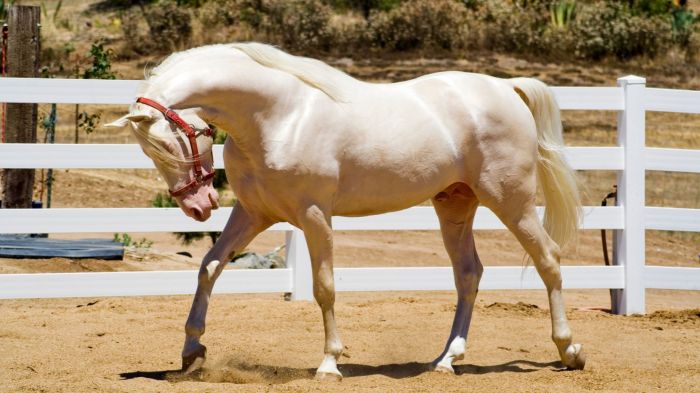The horse with a flecked coat, a captivating sight to behold, has long captivated the imaginations of horse enthusiasts and artists alike. This unique coat pattern, characterized by its distinctive distribution of colored spots, is a testament to the extraordinary genetic diversity found within the equine world.
As we delve into the intriguing characteristics of the flecked coat, we will explore its genetic origins, the breeds that proudly display this trait, and the captivating ways in which it has been represented in art and literature throughout history.
From the genetic makeup that determines the coat’s unique appearance to the specific breeds known for their flecked coats, we will unravel the fascinating tapestry of this equine characteristic. We will also delve into the specialized grooming and care required to maintain the health and beauty of these remarkable coats.
Horse Coat Types
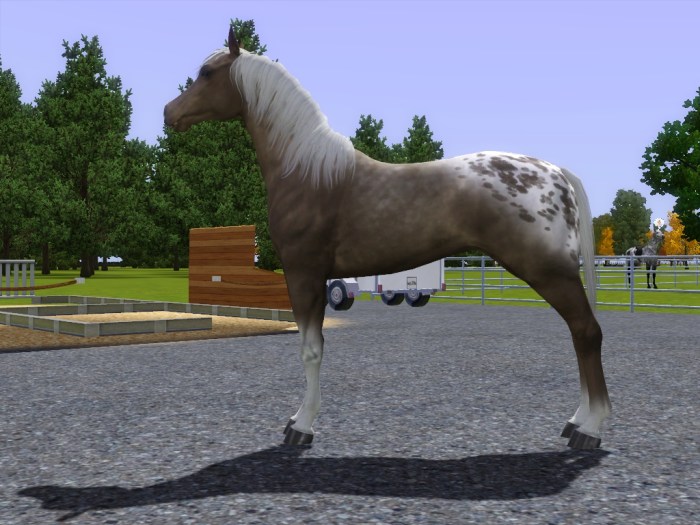
The coat of a horse is a defining characteristic that adds to its beauty and uniqueness. Horse coats exhibit a wide range of colors and patterns, each with its own genetic basis. Understanding the different types of horse coats can help horse owners appreciate the diversity and complexity of these magnificent animals.
The genetic makeup of a horse determines the color and pattern of its coat. Genes control the production and distribution of pigments, such as melanin, which gives horses their distinctive colors. The interaction of multiple genes can result in a vast array of coat variations.
Solid Coats
Solid coats are characterized by a uniform color throughout the horse’s body. Some common solid coat colors include bay, black, brown, chestnut, and gray. Bay horses have a reddish-brown body with black points, which include the mane, tail, and lower legs.
Black horses have a completely black coat, while brown horses have a dark brown coat with lighter brown points. Chestnut horses have a reddish-brown coat with no black points. Gray horses are born with a dark coat that gradually lightens with age, eventually becoming white or light gray.
Parti-Colored Coats
Parti-colored coats are characterized by two or more distinct colors. Some common parti-colored coat patterns include pinto, skewbald, and piebald. Pinto horses have large patches of white and another color, such as black, brown, or chestnut. Skewbald horses have patches of white and any color other than black, while piebald horses have patches of white and black.
Spotted Coats
Spotted coats are characterized by small, round spots of a different color on a base coat. The most common spotted coat pattern is the Appaloosa, which has a white or light-colored base coat with dark spots. Other spotted coat patterns include the leopard complex, which has a solid coat with dark spots, and the sabino, which has white markings on the face, legs, and belly.
Flecked Coat Characteristics
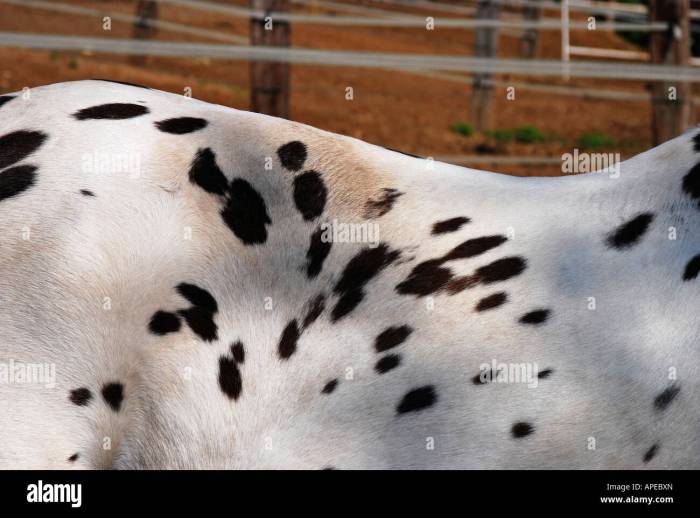
Flecked coats are distinctive and eye-catching, featuring a unique pattern of scattered, irregular spots or flecks on a solid base color.
These flecks are typically lighter or darker than the base color, creating a mottled or dappled appearance. Flecking can vary in intensity, from subtle speckles to bold, contrasting spots.
Genetic Factors
The genetic makeup of a horse plays a significant role in determining the presence and characteristics of a flecked coat.
- Leopard Complex Gene:This gene is responsible for the “leopard complex” of coat patterns, including flecking. It causes the production of melanocytes, which are cells that produce pigment.
- Dilution Genes:These genes, such as the cream gene, can dilute the base color of the coat, making the flecks more visible and distinct.
Horse Breeds with Flecked Coats
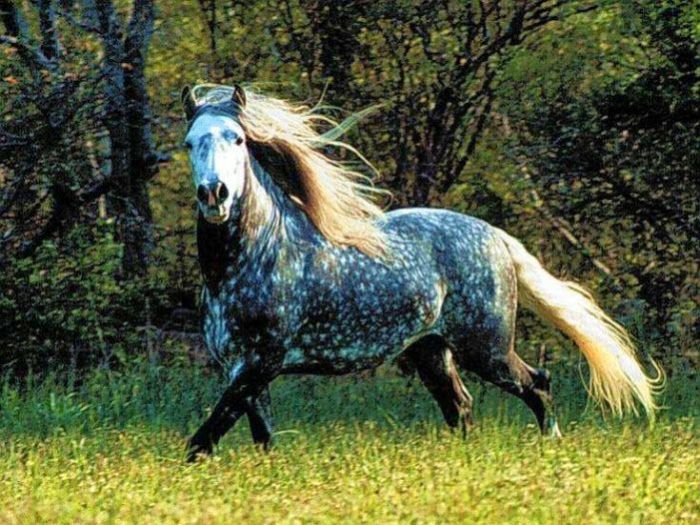
Flecked coats are a unique and striking feature found in several horse breeds. These coats are characterized by small, irregular spots or flecks of a contrasting color scattered throughout the base coat. The flecks can vary in size, shape, and density, creating a distinctive and eye-catching pattern.
Appaloosa
- Known for their distinctive spotted coat patterns, which can include flecks of various sizes and colors.
- Other characteristics include a mottled skin pattern, striped hooves, and a white sclera around the eyes.
Knabstrupper
- A Danish breed known for its striking leopard-spotted coat, which often features flecks of black, brown, or gray on a white base.
- They are also known for their calm and gentle temperament, making them suitable for various equestrian activities.
Noriker
- A heavy draft horse breed originating from Austria, known for its thick, flecked coat.
- The flecks can range from light gray to dark brown, creating a unique and eye-catching pattern.
American Paint Horse
- A versatile breed known for its colorful and varied coat patterns, including flecked coats.
- The flecks can be found in a variety of colors, including black, brown, or gray, and can vary in size and density.
Grooming and Care for Flecked Coats: Horse With A Flecked Coat
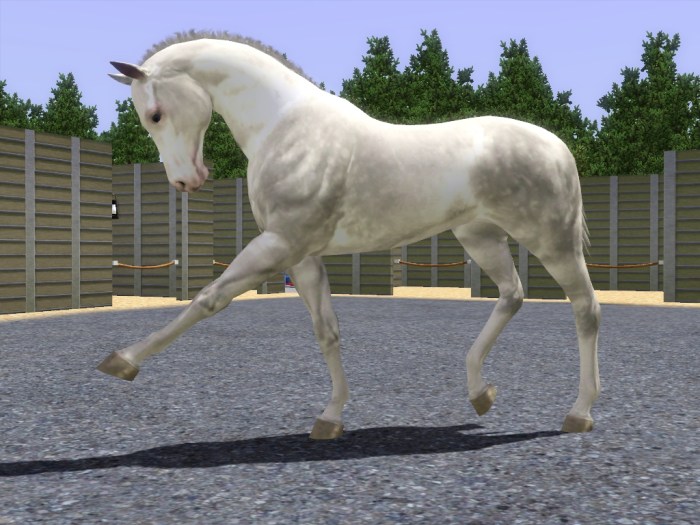
Flecked coats require specific grooming and care to maintain their health and appearance. Understanding their unique needs is crucial for keeping these horses looking their best.
Regular Brushing
Regular brushing is essential for removing dirt, debris, and loose hairs from the coat. Use a soft-bristled brush to avoid damaging the delicate hairs. Brush in the direction of hair growth to distribute natural oils and prevent matting.
The dappled coat of the horse, with its intricate patterns, reminded me of the intricate relationships within families. Just as the flecks of color on the horse’s coat connected it to its ancestors, so too did the bonds of family connect me to my brother in law in Hmong . His presence in my life enriched it, just as the flecked coat enhanced the beauty of the horse.
Shedding Season
During shedding season, flecked coats require more frequent brushing to remove dead hair and prevent it from becoming matted. Use a shedding blade or curry comb to gently loosen and remove loose hair.
Bathing
Bathing should be done sparingly, as excessive bathing can strip the coat of its natural oils. Use a mild shampoo designed for horses and rinse thoroughly to prevent soap residue from accumulating.
Conditioning, Horse with a flecked coat
Conditioning can help improve the texture and appearance of flecked coats. Apply a conditioner after bathing and leave it in for the recommended amount of time. Rinse thoroughly to remove any excess product.
Tail and Mane Care
The tail and mane of horses with flecked coats should be brushed regularly to prevent tangles and mats. Use a detangling spray or conditioner to make brushing easier.
Protection from Sun and Rain
Flecked coats are more susceptible to sun damage than solid-colored coats. Provide shade or use sunscreen to protect the coat from harmful UV rays. Similarly, rain can cause the coat to become dull and lose its shine. Use a waterproof blanket or coat to keep the horse dry in wet weather.
Flecked Coat Patterns in Art and Literature
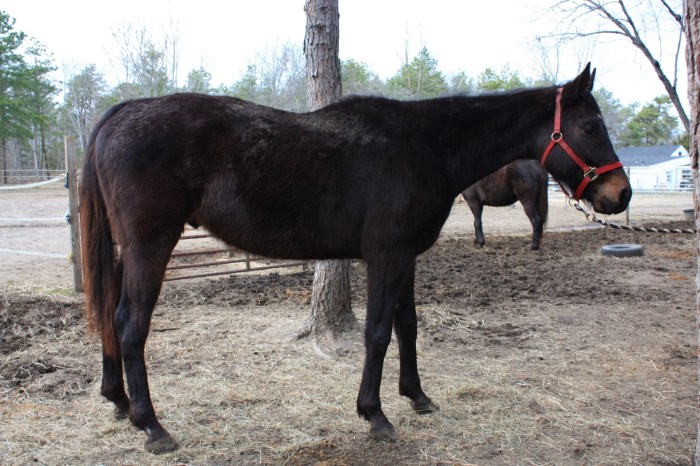
Flecked coats have captivated artists and writers throughout history, inspiring a rich tapestry of visual and literary representations. From ancient cave paintings to modern masterpieces, these unique markings have symbolized beauty, strength, and even spiritual significance.
Flecked Coats in Art
In ancient times, cave paintings depicted horses with flecked coats, capturing their dynamic movement and vibrant coloration. Later, Renaissance masters like Leonardo da Vinci and Raphael used flecked coats to add depth and texture to their equestrian portraits, emphasizing the nobility and grace of their subjects.
In the 19th century, Impressionist painters such as Edgar Degas and Claude Monet immortalized flecked coats in their equine paintings, capturing the interplay of light and shadow on their dappled surfaces.
Flecked Coats in Literature
In literature, flecked coats have been associated with a wide range of characters and themes. In Homer’s Iliad, the hero Achilles’s horse, Xanthus, is described as having a “flecked and dappled” coat, symbolizing his divine origins and indomitable spirit.
In Shakespeare’s Hamlet, the ghost of Hamlet’s father appears in a “inky cloak” with a “flecked and pied” border, evoking a sense of mystery and the supernatural.
More recently, in J.R.R. Tolkien’s The Lord of the Rings, the horse Bill is described as having a “dappled gray” coat, reflecting his loyalty and endurance in the face of adversity.
FAQ Guide
What causes the flecked coat pattern in horses?
The flecked coat pattern is caused by a specific genetic mutation that affects the distribution of pigment-producing cells in the horse’s coat.
Are there any specific breeds known for their flecked coats?
Yes, certain breeds, such as the Appaloosa, Knabstrupper, and Noriker, are known for their distinctive flecked coats.
How should I care for a horse with a flecked coat?
Horses with flecked coats require regular grooming to maintain their coat’s health and appearance. Use a soft brush to remove dirt and debris, and bathe the horse as needed using a gentle shampoo.
